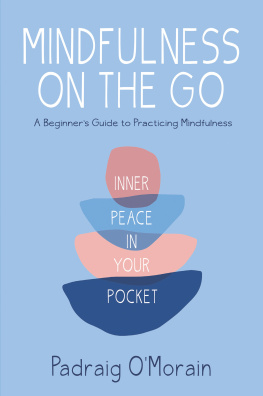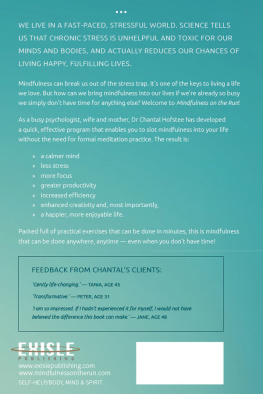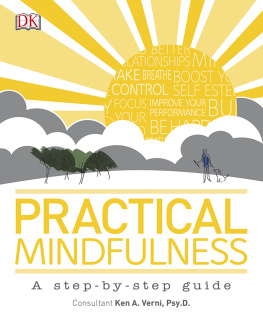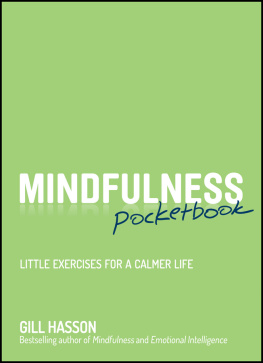MINDFULNESS
ON THEGO
INNER PEACE IN YOUR POCKET
PADRAIG OMORAIN
To Phil, Niamh, Hannah andLil
HOW TO GET THE MOST FROM THIS BOOK
T his book aims to give you anunderstanding of mindfulness with lots of ideas for how to practice it easily duringyour day. It is based on the authors years of practicing and teaching, while also leading a busy familyand work life.
You are welcome to read it straight through or to dip in atrandomwhichever you decide to do, it is important to read first. While reading that chapter youwill find yourself starting to be mindful without any effort, and by the end of thechapter you will have a good grounding in the subject.
Throughout the book I have included variousmindfulness exercises which are spread throughout the text.These are signposted with an On the Go heading, so you can easily locate them. Eachexercise offers a simple practice, designed to help you be more mindful during theday, with an option to go deeper and extend the practice should you wish.
Toward the end of the book there are two sections designed tohelp you make mindfulness part of your everyday life. The MindfulnessCalendar (see ) willhelp you remember to practice every day by inspiring you with ideas. Just find theday of the month and have a go at the suggestion for that date. The last section,Ten Strategies for Everyday Mindfulness, includes tips onfinding windows of time for quick and effective mindfulness techniques.
At the end, the Resources suggest where togo for more ideas and guidance on mindfulness, including websites, books andapps.
Read the , read some more and then turn to the sections that you think mighthelp you most. This book is a tool to be used, so make it work for you. Everythingyou need to practice mindfulness lies within these pages, so lets get started, andremember that practice is the key to developing this invaluable lifeskill.
CONTENTS
MINDFULNESSAND WHY YOU
SHOULD PRACTICEIT
O nly acouple of decades ago few of us had heard of mindfulness, yet today it seems to bethe word on everybodys lips, with big companies, sports organizations, hospitals,trade unions and all manner of individuals from tycoons to parents who are teachingor using it.
But one thing that puts many more people off trying outmindfulness is that they are convinced that it will take up more time than they cangive to it. They know they are never going to sit and observe their breathing fortwenty minutes a day. Indeed, you yourself may even have tried and given up when thebusyness of life got in the way.
The good news is, however, that mindfulness is an attitude aswell as a practice. And, even better, there are quite short practices that can helpyou to develop it and enjoy its benefits.
Even in this frantic world, mindfulness practice can give youa sense of spaciousness and a perspective that will help you to see more clearlywhat needs to be done at work, at home and at play.
So if you have very little time on your hands, but would liketo give mindfulness a try, this book is for you. Lets begin with some of thereasons why you might think you cant practice mindfulness.
I CANT PRACTICE MINDFULNESS BECAUSE...
... I am too busyto be mindful. Awareness of what is going on right now in an acceptingwaya key aspect of mindfulnesswont interfere with your busyness, but it will giveyou a welcome and valuable sense of calm and self-possession in the middle of it.For instance, glance around the space youre in right now. As you do so, can you puta very light attention on the sensation of your breath as it enters and leaves yournostrils? Let your mind go quiet for a few moments. Thats a mindfulness practice,and it takes no more than a few seconds, yet it can help you to lift your head outof the busyness of your day.
... I am too busyto sit and meditate. As its title suggests, this book will show you howto practice mindfulness on the go. None of the mindfulness practices in the bookrequire you to sit and meditate for lengthy periods. For instance, breathing in to acount of seven and out to a count of eleven (the / practicesee ) is very calming. It alsotakes less than half a minute to do. Try it and see.
... Im a parent ofyoung kidswhere am I supposed to find quiet spaces in my life? ThatsOK: This book will show you how to practice mindfulness and scream at the kids atthe same time! And if you learn to observe their shenanigans without crowding yourmind with judgments about themor about yourselfyou might even scream less often.For instance, take a moment right now to notice where in your body you feel a senseof calmness and groundedness. This might be somewhere between your chest and yourtummy or it might even be at the tip of your nose. Next time the kids are drivingyou mad (or youre driving them mad), try to retain an awareness of that center ofgroundedness.
... I cant do thelotus position and I dont like all this Buddhist stuff, anyway. Mindfulness has nothing to do with the lotus position. People who practicemindfulness in the Buddhist tradition sometimes meditate in that position, but Iwont be asking you to do anything like that. Next time youre sitting in a chair,notice the feeling of your back against the back of the chair and of your feetagainst the soles of your shoes. Thats a brief mindfulness practice that doesntrequire the lotus position.
... I dont havethe time to read long books about mindfulness. Thats why, as books go,this is a short one. And its designed so that you can dip in at any time to find amindfulness idea or suggestion you can practice in a way that fits in with a busylifestyle. For instance, what can you hear right now in your vicinity? Can youlisten for about twenty seconds without telling yourself a story about the soundsand without interpreting them? As you do this, if a story or interpretation comesinto your mind, return your attention gently to the sounds. Thats an example of amindfulness practice that you can do in a very short period of time (although, aswith all the practices in this book, if you want to spend longer periods doing it orif you want to set aside a little time on the weekends for a mindfulness meditation,thats good too).
So now that weve dealt with potential obstacles andestablished that mindfulness might be for you, lets look at what it actually is andhow it is good for you.
WHAT IS MINDFULNESS ANYWAY AND
WHY WOULD I WANT TO DO IT?
Think of mindfulness as returning. Its assimpleand as difficultas that. Mindfulness is about returning your attention againand again to whatever is going on for you right nowbut in a special way: withoutarguing with reality (see Mindfulness is acceptance). By dropping that argumentyou learn to appreciate what is there to be appreciated and you enhance your abilityto see what needs to be changed. The benefits are manifold, as I outline below.
Mindfulness is acceptance. Ithink this is probably the key thing to remember. Most of us find the concept ofacceptance hard to understand. One of its meanings is that you dont use energycomplaining to yourself about the things that you can do nothing about right now:its raining outside or you dont like your job or your spouse is annoying. It ispossible to waste vast amounts of energy complaining about things like these. But,ultimately, where does that get you? It doesnt stop the rain from falling, it wontmake your job wonderfully exciting and it wont change your spouses annoyinghabits.
We spend a lot of our time in a sort of trance, made up ofmemories, fantasies and other thoughts. This almost always holds us back. Instead,step out of the trance and into direct experience of your reality. If you practicemindfulnessby which I mean, among other things, stepping out of the old storiesthat your mind wants to tell you and learning to accept things for what they areyoumay ruefully note these facts, but you will be less likely to argue with what youcannot change. You will also waste less energy getting stressed and upset aboutreality. And the extra energythe extra mental space that you get from thatwillmake you far more skilled at identifying what










